#Forensic Structural Engineer
Explore tagged Tumblr posts
Text
Forensic Structural Engineer

At BSD Consulting, we deliver precise forensic engineering expertise for a wide range of clients, including real estate agents, property managers, homebuyers, insurance companies, and more. Our investigations uncover the root cause of structural issues, enabling actionable and cost- effective rectification plans.
Learn more: https://www.bsdconsulting.com.au/forensic-engineering/
0 notes
Text
Why Hiring a Stormwater Engineer in Melbourne Is Essential for Your Project
In a city like Melbourne, where urban development continues to grow and climate variability poses increasing challenges, hiring a stormwater engineer in Melbourne is not just important—it’s essential. Stormwater management is a crucial aspect of any residential, commercial, or civil construction project. It ensures that rainfall runoff is effectively directed, treated, and discharged without causing damage to structures, surrounding properties, or the environment.
Understanding the Role of a Stormwater Engineer
A stormwater engineer is a civil engineering professional who specialises in the planning, design, implementation and structural forensic inspection of drainage systems that manage rainwater runoff. Their responsibilities range from designing retention basins, detention systems, and stormwater pipes to assessing flood risks and ensuring compliance with local council requirements and environmental regulations.

Why Stormwater Management Cannot Be Overlooked
Improper stormwater management can lead to several issues:
Localised flooding
Soil erosion and land degradation
Water contamination
Infrastructure damage
Breaches of planning permits or environmental legislation
Given Melbourne’s variable weather and history of extreme rainfall events, addressing these challenges early in the planning phase is critical. A stormwater engineer in Melbourne can analyse site conditions, forecast stormwater impacts, and develop cost-effective and sustainable drainage solutions.
Compliance and Certification
Stormwater drainage works must often be certified for compliance with Melbourne Water or local council requirements. Engineers provide documentation such as drainage plans, MUSIC modelling reports (used to model stormwater treatment performance), and flood impact assessments. Without proper certification, your project may not receive the necessary approvals, delaying construction and increasing costs.
Improved Project Efficiency and Environmental Outcomes
Hiring a stormwater engineer also contributes to more sustainable development. These professionals design systems that improve water quality, reduce pollutant loads entering Melbourne’s rivers and bays, and integrate water-saving practices. Whether you're building a new home, developing a commercial site, or undertaking a public infrastructure upgrade, their expertise enhances long-term functionality and environmental performance.
Hiring a qualified stormwater engineer in Melbourne ensures your project meets all compliance standards, mitigates environmental risks, and maintains structural safety.
Source: https://emsengineeringconsultancy.blogspot.com/2025/06/why-hiring-stormwater-engineer-in.html
0 notes
Text
What Can Forensic Structural Engineering Reveal After a Building Fails?
Structural failure isn’t always caused by a single mistake. Often, it's the result of multiple small issues that build up over time. Forensic Structural Engineering is the field that investigates these failures to understand exactly what went wrong. It brings together engineering knowledge, site inspection, and factual data to create a complete picture.
In real-life cases, Structural Forensic Engineering professionals examine structural elements like beams, joints, and load distribution. They look for warning signs that may have been overlooked or ignored. Their work often reveals hidden design missteps or unexpected pressure points that contributed to the collapse.
The detailed process of Forensic Engineering Analysis also helps improve future building practices. Engineers and safety professionals rely on these findings to strengthen construction methods and prevent repeat failures. Read the full blog for more information - https://appliedscienceint.hashnode.dev/what-can-forensic-structural-engineering-reveal-after-a-building-fails
0 notes
Text
JBLUEPRINTS STRUCTURAL ENGINEERS
Address:
182 Cobblestone Dr, Dallas, GA 30132
Phone:
470-318-2711
Website:
Business email:
Description:
Structural engineering firm specializing in structural inspections and engineering drawings and city permit plans.
We inspect buildings, create as-built floor plans, remodel layouts, remove walls, create additions and provide full city permit blueprints.
We deliver either inspection reports or complete construction blueprints.
Jblueprints Structural Engineers is a Georgia-based firm specializing in structural engineering inspections and consulting services for residential, commercial, and industrial buildings throughout the state of Georgia, South and North Carolina, Alabama and Florida. The firm is known for its prompt service, often scheduling inspections within 24 hours and delivering reports shortly thereafter. They cater to various clients, including homeowners, investors, developers, real estate professionals, contractors, and insurance companies, ensuring that structures meet safety standards and regulatory requirements.
Schedule Call link
Social Links:
https://www.instagram.com/jblueprints_structural/
https://www.linkedin.com/company/jblueprints
GMB link:
#Structural Engineering Inspections#Residential#Commercial#Industrial#Buildings Assessment#Mobile Home Foundation Certifications#New and Existing Construction Framing and Foundation Inspections:#Property Condition Assessments.#Construction Additions and Remodeling#Forensic Disaster Restoration Assessments: hurricanes#wind#impact#tornadoes#or fires inspection reports and repair drawings#Engineering Reports and Letters#As-Built Drawings and Floor Plans#Permit Drawings and Engineering Calculations#Retaining Wall and Foundation Design#Site Plan and Property Plot Plans#Septic Tank Design#Georgia#Alabama#Carolina#Florida.
1 note
·
View note
Text
How Forensic Structural Engineering Detect Balcony Faults?

Keeping your balcony safe is important to avoid any safety hazard. Understanding when to call forensic structural engineering services is the need of the hour.
0 notes
Text
Integrating Advanced Software for Demolition, Forensic Engineering, and Structural Analysis
In the modern engineering landscape, advanced software solutions offer essential tools for various specialized tasks. Demolition software is crucial for planning safe and controlled structure dismantling, minimizing risks. Similarly, forensic engineering analysis software helps engineers investigate structural failures by simulating different scenarios, leading to insightful failure analysis. Structural analysis software plays a vital role in assessing load-bearing capacities and ensuring the stability of structures. Together, these technologies enhance project safety, efficiency, and precision.
Read the complete Blog here: https://extremeloading11.medium.com/integrating-advanced-software-for-demolition-forensic-engineering-and-structural-analysis-ff18148f039e
0 notes
Text
The Enigmatic World of Forensic Engineering
In the intricate tapestry of modern engineering, a specialized discipline exists, dedicated to unraveling the mysteries behind failures and ensuring a safer world. This realm is known as forensic engineering, a field that employs meticulous scientific methods to investigate the root causes of accidents, structural collapses, and product malfunctions. Forensic engineers are the detectives of the…
0 notes
Text
0 notes
Text
What college major is best for you based on you 9th house.

Earth signs:
Capricorn 9th house: dentistry, investing, business, chiropractic studies, finance, engineering, cheif executive ( any major that deals with discipline & structure
Virgo 9th house: Performs well with majors involving acts of service(nursing, social work, psychology, teaching, accounting, dietitians, health care)
Taurus 9th house: Finance, Business, accounting, culinary arts, food science, real estate, agriculture business, investing, design (a calm and stable work environment with assured stability is best).
Air signs:
Gemini 9th house : communications, telecommunications,public administration,public relations, teaching, sales, advertising, art & design( any majors that encourages mental growth & really gets you to socialize & think)
Libra 9th house: law, politics, esthetician/ skin care specialists, real estate,
Aquarius 9th house: Computer science, engineering tech related, space related majors, mechanics.
Water signs:
Cancer 9th house: Real estate, nursing, pediatric care, child psychology, physical therapy, dermatology.
Scorpio 9th house: psychology, anthropology, mortuary services, accounting, finance,cognitive science, Forensics, casino management, banking, criminal studies (does well with deep & taboo majors).
Pisces 9th house: music, astronomy, journalism, film, literature,therapist, environmental science, earth science, biochemistry.
Fire signs:
Aries 9th house: militaristic studies, flight, fire studies(prevention, protection,investigation,) fire fighting, law, business, engineering, entrepreneurship, kinesiology.
Leo 9th house: Acting, Dance, design & applied arts, drama, Film, Art, Hairstyling, advertising, pediatric, teaching, social work, entertainment services.
Sagittarius 9th house: Aviation( flight degrees, philosophy, religious studies. Foreign languages, cultural studies, theology.
#astrology signs#spirituality#psychic#pisces#aquarius#capricorn#sagittarius#scorpio#aries#astro community#astro observations#astrology#astro notes#nail art#stars#astroblr#witchblr#birth chart#astrology chart#venesianthoughts#natal chart#astrology community#zodiac#zodiac signs#horoscope#sun#predictions#college#major#university
621 notes
·
View notes
Text
An Undergraduate Forensic Viewing of Like Minds (2006) Train Scene

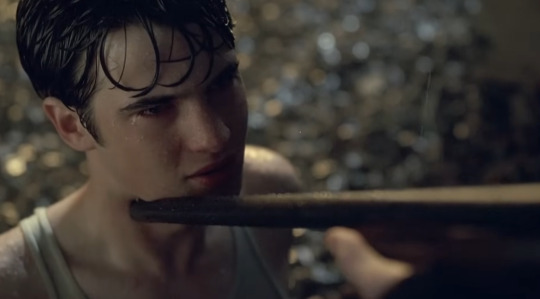
Pray for me. Pray for yourself. We are one now.
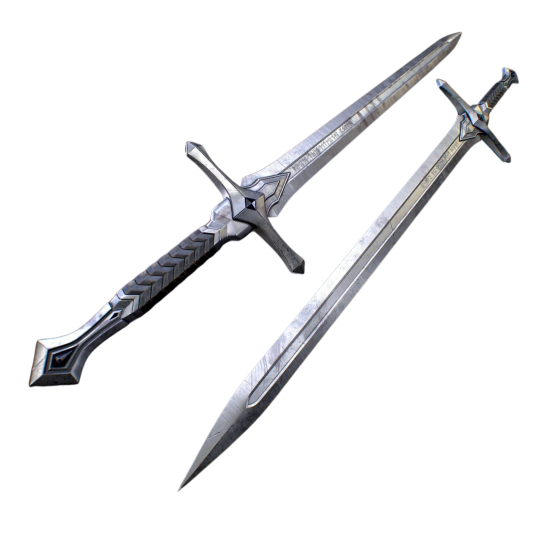
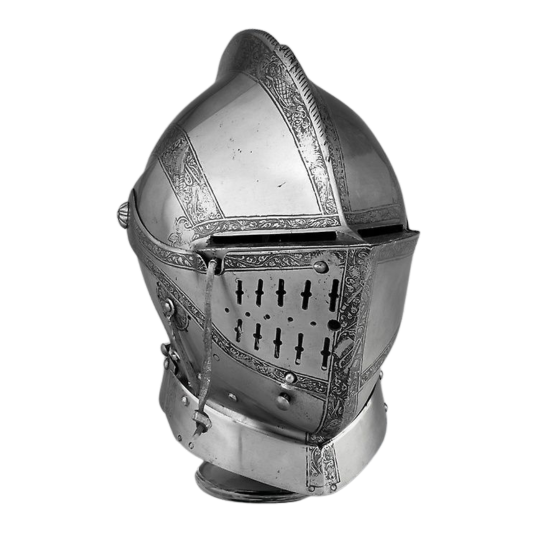
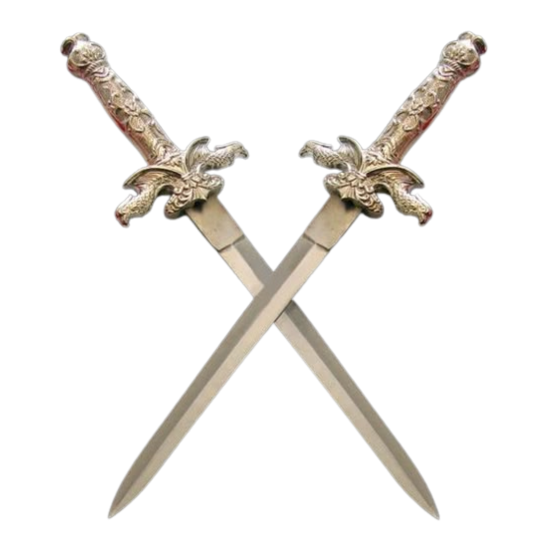
Contents:
1. Introduction 2. What We Know 3. The Investigation 4. Bibliography for Nerds

1. Introduction
Some justifications first.
I'm an undergraduate stem student obssessed with many topics, including forensic studies. I just finished a complete course about forensic chemistry/tecnology/law in uni and yes, I'm a big failure of a person and was thinking about applying some of the things I've learned into Like Minds' train scene. To clarify, I'm not an experienced profissional of the field. It is to say, I've never worked in such area and had just one or two significant interaction with said profissionals and students. My considerations won't be 100% accurate, clearly, and I may mistake or ignore fundamental data and studies. I intend solely to present some interesting facts and rapidly discuss their applicability here.
Take everything I say with large grains of salt, this is mostly for my enjoyment.
Let's kill Nigel!
2. What We Know
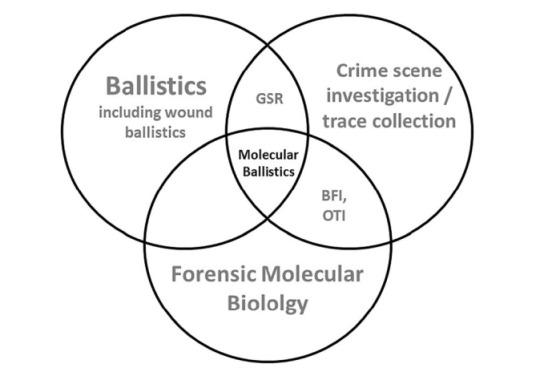
Figure 1. Visual diagram of forensic ballistics' main areas of study. Some will be mentioned here. [1]
2.1. Ballistics - Anatomy of a Discharge
Ballistics is a science field divided in three main ramifications: (1) Interior Ballistics, (2) Exterior Ballistics and (3) Terminal Ballistics. (1) studies the mechanism of a gun discharge, (2) studies the trajectory and behavior of a projectile once it is ejected from a firegun and (3) studies the damage and overall interaction of the projectile with a material structure (biological or not). [1] Ballistics experts (chemists, some engineers, law experts, etc) ocuppy themselves with many things regarding firearms, a field of work that recuries much study and understading of multiple fields of knowledge such as spectroscopy, law and general legislation, physical properties of chemical coumponds, solid state science, material science, industry production series and others. Some areas of chemistry and biology are of great importance and are commonly used complementarily.
We then understand what bullets are. The component that effectivally hits the target in these scenarios is the actual "projectile".
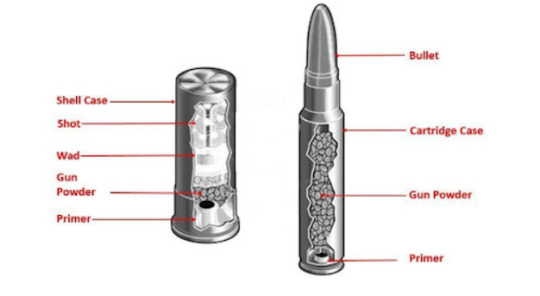
Figure 2. Simple structure of shotgun (left) and rifle (right) ammunition. [2]
In simple terms, they're composed by (1) a shell that holds everything together, (2) some coumpond responsable for the liberation of gas via chemical reaction and (3) some way to give the heat needed for said reaction to occur. There is a whole field of study and production of these killing objects that seeks out to balance some of their properties in different scenarios by the armamentist industry in oder to supply endless applications that constantly develops new shapes and components, so going through it all would be impossible. Regardless, all ammunition is classified by size, called "gauge" in shotguns, and "caliber" in rifles and handguns. [2]
Case: [in shotguns] It is a small cilindrical piece made out of a tube of common plastic or sturdy paper (the red/blue/colored part) that holds the multiple projectiles to be fired (shots), with a metallic base (the primer) composed of brass (copper and zinc) or steel (iron and carbon). [in rifles] The case is called cartridge case, and it is composed by brass as well. [2]
Powder (or propellant): They are usually Nitroclelullose (handguns), Nitroclelullose/Nitrogliceryn (rifles) and Nitroclelullose/Nitrogliceryn/Nitroguanidyn (long range rifles) [3]. Oversimplifying, organic molecules containing nitro groups (present in Nitroclelullose, Nitrogliceryn and Nitroguanidyn) are really unstable; these chemical groupaments are highly reactive in face of many scenarios. If enough energy is provided (by heating, or mechanical contact and pertubation) they will enter a decompostion process, breaking and reacting with their own bonds spontaneously, liberating gases such as H2O, N2 and CO2. These mentioned gases are much more stable compared to the original organic coumponds, so the atoms will "prefer" to form these species if the conditions are set (thus, a spontaneous reaction). This increases pressure inside the shell and forces the projectile to leave violently as a result of gas expansion. [4] Shotgun powder is composed by potassium nitrate, charcoal and sulfur; a mixture known as "dark powder", and it is separated from the shot (projectiles; multiple balls of steel, lead, rubber, or really anything) by a small component called "wad". The same principle explained in the decomposition of organic nitro-compounds apply for the potassium nitrate present here, but only in the presence of sulfur (easier to melt and ignite), providing the necessary heat for potassium citrate to generate the oxygen needed, resulting in charchoal's combustion. [2]
Primer: Primers are a fundamental part of any ammunition, and yet a simple one. When a firing pin from the firegun hits them, sparkles and heat will be produced, which gives the propellent all requiered energy for the chemical reaction. It is, when the action lever is pulled, the firing pin is tensioned by a spring inside the gun. When the trigger is pulled, this firing pin hits rapidly the ammunition's primer (metallic base). [5]
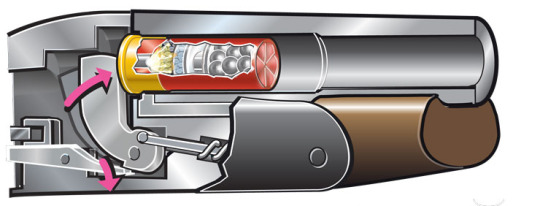
Figure 3. Shotgun firing pin scheme. [5]
The discussion of differents powders/propellents (like smokeless powder), projectiles shapes (in rifle cases) and firegun types (other than rifle and shotgun) is being ignored.
All that must be known is: the trigger pulling promotes a mechanical impact against the ammunition base, which promotes chemical reactions that liberate great amounts of gases, increasing the pressure inside the case, what will pushes the projectile(s) inside foward with great speed.
2.2. The Shotgun - Means to An End
We now restrain ourselfs to the firegun. Let us take a look on the following images:
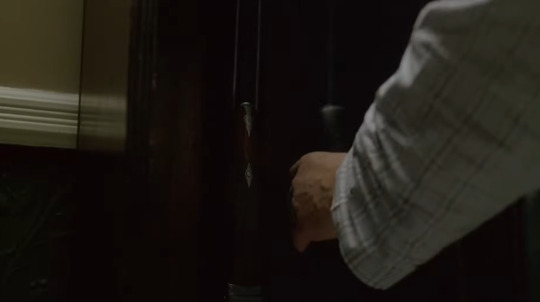

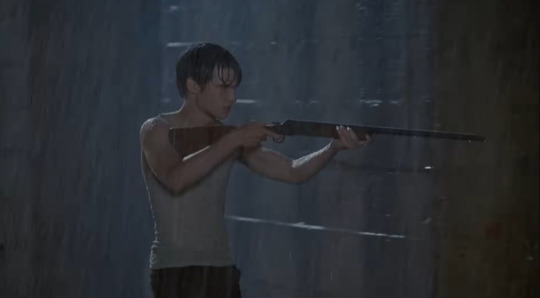
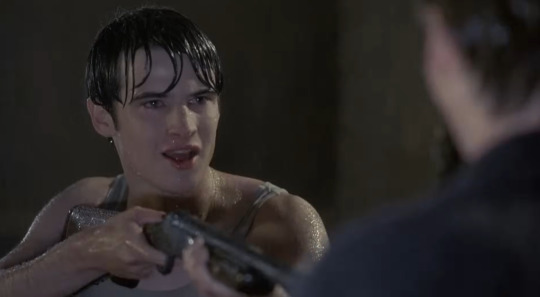
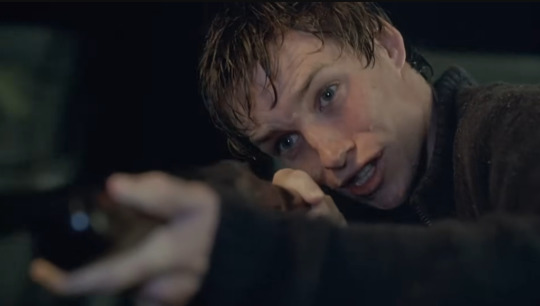
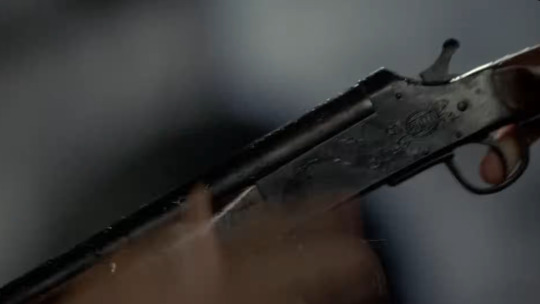
Figures 4-9 (left to right, top to bottom). Shotguns' takes from Like Minds (2006).
Main considerations:
The shotgun used by Mr. Colbie isn't the same one used by Nigel/Alex in the train scene. We can clearly point that by the number of barrels, i.e., two barrels contaning two projectiles (killing Nigel's mother and father without visible activation) in its first appearance, and only a single one in its second appearance. Maybe this has been discussed before.
It is not a narrative problem if we have the eyes for it. Nigel's father possesses two shotguns, so we assume Nigel went back and grabbed the single-barrel one before going after Alex.
The reloading thing would be important during the bedroom scene, between the moments where John shoots his wife and Alex picks up the gun from the floor. There would be no way of aciddentially shooting Mr. Colbie wihout Alex pulling the action on the second barrel (how would he know which one of the barrels were loaded and why Mr. Colbie would only activate one of the two barrels? It appears he wasn't using the shotgun to merely scare his family). Perhaps the double barrel shotgun used has some individual firing feature, perhaps.
Also, the single barrel shotgun is the same one used by John when Alex and Nigel first accessed the hidden baseament together. This isn't of great relevance though.
After a compulsive research in gun sale sites and over 900 models of shotguns (no joking), I'm inclined to believe that Nigel's single barrel shotgun is an Era 410 GA Single Shot Break Action. My conclusions is based on Figures 6 and 9, the shotgun's best takes throughout the entire movie. The important details are: a single barrel, with rounded trigger guard that ends exactly where the wooden stock begins, by a rounded break action lever with squarish shape that leans horizontally to the receiver and a rectangular like forestock. Other smaller details are: the receiver's top shape and really curved back, the declination present on the stock and the three screws' position and size.
The engraved symbols on Colbie's receiver are sculpted by a profssional artist called "engraver", by client's demand. Therefore, these sigils are decorative and probably carry some meaning to the shotgun's real owner, so they aren't a discrepancy to worry about. The frame I acquired (Figure 9) is of poor quality and there's nothing I can read in there besides one or two letters. I've tried to watch the movie in other internet sites but it didn't help that much.
It took me forever, but here it is [6], [7]. There are also youtube videos revewing this gun in the Extra section.

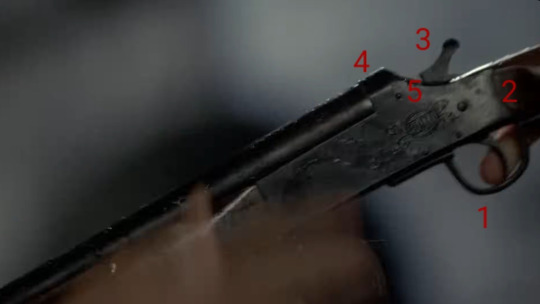
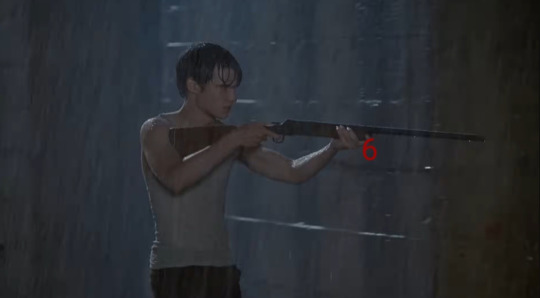

Figures 10-13. Era 410 GA Single Shot Break Action Shotgun. [6]
Note: @laurelwen successfully identified Nigel's firegun as a Boito .410. The text engraved on the shotgun's receiver in Figure 9, in fact, reads "Boito". Check it out on this post. Look up Extra Bibliography No. 7 in the shotgun's section as well.
Shotguns are a really old type of gun from the 16th century. Their mechanisms were adjusted during following centuries, but they remain still to date with an extremely simple way of function. Today, there are many types, including the single-shots and hand shotguns, much different than what was originally conceived. A break shotgun is capable of "breaking in half" for reloading, exposing its ejector/extractor and barrel interior just as many other fireguns. [8]
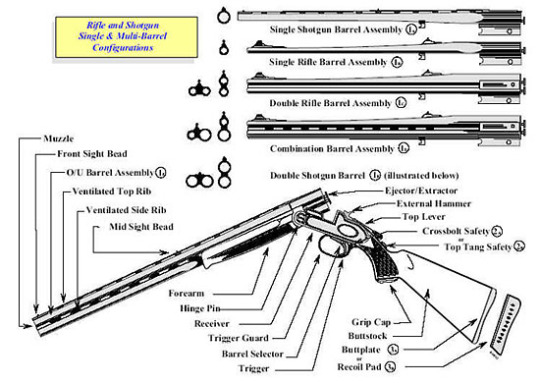
Figure 14. Break action shotgun anatomy. [9]
The Era 410 GA possesses a specially long length of barrel, which helps projectiles to achieve maximum velocity before leaving. Still, it appears from my research that this is a second hand model with low price, low demand and little historical relevance. This is the type of gun that would be bought mainly by collectors and enthusiasts; however, because of its little weight, good shooting and minimalist elegance, this firegun is not one of the worst models out there for small amateur animal hunting.
A 410 (10.41 mm, one smallest shot diameter in the market) with great pattern of dispersion after the discharge isn't bad, so at medium distances most projectiles would succesfully hit the center of a target. This is not very good when we're talking about a point-blank discharge directly at Nigel's face.
3. The Investigation
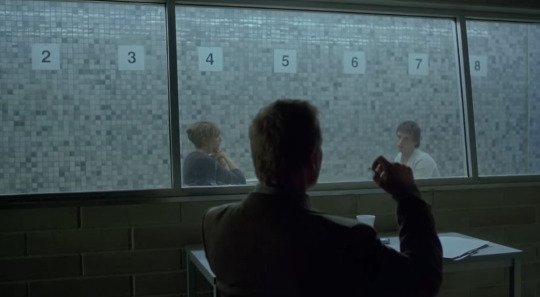
Figure 15. "If they had any evidence, I wouldn't be talking to you, would I?"
Authorities arrive at the dark, umid and isolated train tracks. Immediatly, a shocking scene: a desperate young man holding in his arms the corpse of a dead boy, disfigured. They transport the living witness away from the scene, but the lying unknown and deformed body is extracted for further autopsy. Detective McKenzie takes over with Forensic Psychiatrist Sally to interrogate the surviving suspect, Alex Forbes.
After the initial approach and first hours of interaction, the case takes an unexpected form. The question now is, did Alex Forbes shoot the now identified Nigel Colbie alone, or did Colbie participated in his own killing to incriminate Alex?
The police wastes its time thinking about common scenarios described in the book. They know the victim, the place where it happened, the exact gun used and the main suspect. Everything comes down to answering the presented question. Psycological attempts of extracting an answer from Alex by closed sessions with Sally, it is, to try and build a thrust and comfort relation with the suspect in order to obtain a confession would be protocol. But Alex clearly is beyond that, and if we must say, he's in control the whole time.
All that is left for the police is to attach towards factual evidences. Now, we describe two fundamental forensic elements of a gun-related crime.
Gunshot Residues (GSRs)
GSRs are one of the strongest evidences when it comes to forensic studies. Being composed of burnt and unburnt organic or inorganic particles from the explosive primer from the shell, propellant and possibly fragments of the bullet, cartridge case, and even the firearm, they frequently contain elements such as Sb (antimony), Ba (barium), Pb (lead) or Zn (zinc), Cu (cooper), and Ti (titanium). Their deposition concentrates away from the firearm into the shooter's (arms, face, hands and chest mainly) and victim's (region of contact mainly) bodies. GSRs can be found in nearby surfaces as well, such as the floor, ceiling, walls, objects, clothes, etc. The direct deposition of these residues must be carefully used as evidence because of its irregular distribution on the surrounding enviroment after the discharge. Thus, the main factors are always the chemical composition and concentration spots. Shotgun shots (the small spherical projectiles) are usually made up of lead or lead/antimony, but some ammunitions use steel, zinc-plated steel, tungsten and bismut in substitution (So, in our case, we can expect more significant ammounts of antimony/lead or zinc, iron and carbon). [10], [11]
A 410 ammunition is classified as "birdshots" ammunition, used for hunting said animals. The little diameter of projectiles allows the carrying of multiple projectiles inside one shell, facilitating the execution of small moving targets. The potential damage mustn't be underrated, though.
The aforementioned substances/elements can be detected, investigated, and quantified using microscopy, chemical analytical and chemometric methods, such as Scanning Electron Microscopy (SEM), Energy Dispersive X-Ray Spectroscopy (EDS), Atomic Absorption Spectroscopy (AAS) and Energy Dispersive X-Ray Fluorescence (EDXRF). All these techniques are extensively known and applied in uncountable areas of science for identification and characterization of solid materials. In a nutshell, these methods revolve around the interaction of matter with radiation (such as X-Rays) and the energy absorved/emitted by it after the interaction. The SEM is a most usefull analysis for it can provide real images of micro structures and particles present above any surface, like clothings, skin, fifregun metal and others, if properly prepared. [10]
It is important to understand that these identification methods are of extreme precision and sensibility, it is, minimal concentrations can and will be detected inneviatbly.
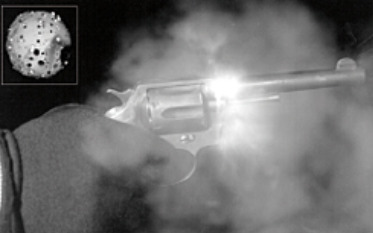
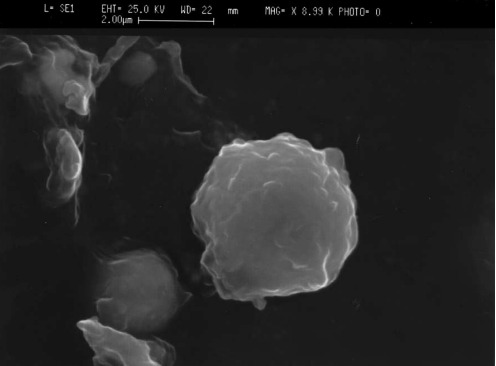
Figure 16 and 17. (Left) Image of gunshot powder residues dispersed in the air after discharge. Top left and (Right) images refer to SEM "photos" of extremely small particles of GSRs that can be chemically analyzed. [12], [13]
What about the lifespan of these residues? In long terms, the shooter's trigger hand (right hand) seems to contain most of the residues that persist for a fair amount of time after the discharge. [10] Unffortunately, the mentioned study occured in controlled enviroments, which is not the case. Another work [14] concludes that most GSRs are lost after two-four hours from the discharge. Considering the fast action from authorities described in the movie, we can basically ignore this factor and consider other variables.
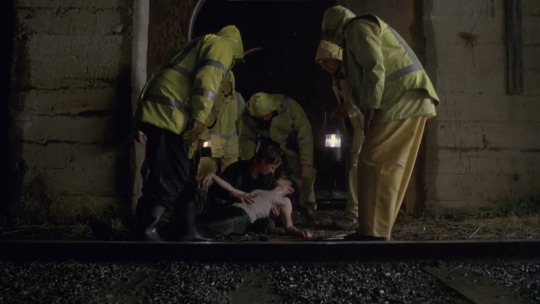
Figure 18. "All I can tell you, was that the heavens were falling. And the sound... it was incredible. It was like the Gods were rejoicing for what was done."
Backspatter Material (BM)

Figure 19. Distribution of Forward Spatter and Backspatter caused by a shot at a biological target. [1]
We hereby exclude the forward spatter, it is, the biological material projected fowards with the projectile (to the back of Nigel's head), for its little relevance, since we're not questioning the type of gun or ammunition used; we assume that Alex is describing a resonable scenario that matches with the actual damage done to Nigel. There are no consistent reasons to question this since everythings seems to support Alex's description of this.
BM comes from the combined forces of several interacting wound and ballistics effects. The collapse of the wound cavity and balance of resulting overpressure, the stream of liquid and tissue particles accelerated along the lateral surface of the projectile, the shot's contact and ejection of muzzle gases out of the entry wound from the powder cavity... Every surrouding surface must be investigated, that is, even the shotgun barrel's interior. This small ambience is fairly protected from external pertubations and houses BM from the shot. Considering the poximity with Nigel's face, we can almost assure to encounter biological material with DNA inside. The bellow mentioned study cites another work where a 9 mm pistol cointaned backspatter material from test targets even at a distance larger than 1 meter, much greater then the few inches that separated Nigel's face from the barrel. [1]
Matter of fact, this biological material can pass by processes of Organ Tissue Identification (OTI) and Body Fluid Identification (BFI) if Nigel's identity was at question, or if we desire to understand more profundly the projectile's damage caused to his skull/face/tissue. [1]
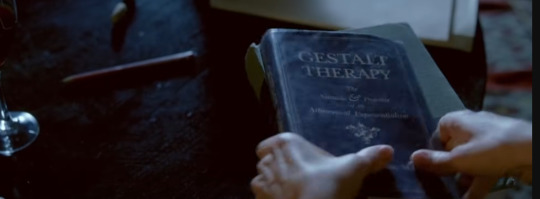
Figure 20. "None of what I've heard makes him a murderer."
So, how can we gather this up to develop the investigation? Utilizing only these two fundamental concepts, we can make a few assumptions.
The big question here is if whether or not Nigel's hands were present by Alex's when the trigger was pulled, which would lead the police to support or oppose Alex's narrative. Chemical examination with organic solvents (which won't cause preocupant harm to a dead body) and analytical methods could immediatly point to the presence of GSRs or biological/non biological BM. If Nigel's hands were elevated in his head level (or superior) in the instant of discharge, trace amounts of discussed metals/elements coming from the firing mechanism and ammunition, as weel as little to some biological material, would definetly be found in his hands and forearm skin since there was no clothing covering. Any substance found in his hands/forearm could be microanalytical compared to the ones present in Alex's hands, clothes and face as well. This could be done with really small samples of fresh skin. On the other hand, if Nigel's arms were lowered at the instant of discharge, we could still expect the presence of GSRs in his arms (yet, in less amounts) but the abssence of backspatter materials most certantly. This would classify Alex as a murderer without excuses, even if he alleged that Nigel asked for it.
In the scenario where Alex discharges at Nigel from a great distance (configuring simply murder) we could note the abssence of GSRs in every part of Nigel's body except for the targeted region (perhaps if they were at a greater distance to each other) and the presence of these GSRs in Alex, but in much higher concentration.
But the enviromnent's conditions are of primordial importance. Nigel and Alex stand in an open area, with considerable wind, heavy rain and gravel soil. The heavy rain could simply carry way much of these residues from Alex's body, clothes and Nigel's hands as well. Most GSR would probably be lost to those conditions and its deposite upon the soil's surface would be extremely hard to be quantitatively analized due to unknown degrees (elevated) of impurities and diverse materials and dirt present, but qualitative tests would still be valid.

The knowledge about the victim, crime scene, shooter, exact firegun and time of the tragic event allied with the fast action from authorities saves most of the police's efforts on identifiying and tracking down evidences. However, what remains still offers a challenge. The best evidence here, GSRs left by the discharge, would be of questionable help considering the presence of heavy rain in sight. Still, analitical quantities of them, if detected in Nigel's skin by proper chemical and espectroscopy-related analysis, can be used to comparate probable ammounts present in Alex's clothing and skin (despite the difficult of such). With that being said, the police would find themselves in a much more complex case of muder/assisted suicide, and further evidences and information about their relationship and recent whereabouts would ineviatably need to be extracted from external sources (such as parents, school's employess, close friends and students). Despite all this, Alex's final acting of removing Susan's body and disapearing from sight (not to mention the card left in Sally's car) immediatly sustent his guilt in a case where he already was the main suspect and basically confirmed criminal. And you know, breaking into a cemetery and extracting a corpse from its grave is definetly worth of some jail time. The Colbie's House Murder would certainly incriminate Alex for homicide as well, and the current Brotherhood's little political influence wouldn't prevent him from this destiny, as it appears. But the case is not over.
Further evidences were to be discussed, if it was not for the dissapearing of Alex Forbes.
The subject now roams unknowingly through England with mysterious intents. Its participation on the described case still lacks formal arguments and the Court should now approve his arrest warrant and search decree. Alex Forbes will most probably live to perpetrate the deluded fantasy responsable for the death of three young students in order to carry the sacred holy burden of an ancient templar bloodline.
Yet, we pray.


Who's the enemy now? We are.
4. Bibliography
[1] Euteneuer J, Courts C. Ten years of molecular ballistics-a review and a field guide. Int J Legal Med. 2021 Jul;135(4):1121-1136. doi: 10.1007/s00414-021-02523-0. Epub 2021 Feb 16. PMID: 33594457; PMCID: PMC8205864. [2] https://spotterup.com/how-ammo-works/ [3] Serol, M.; Ahmad, S.M.; Quintas, A.; Família, C. Chemical Analysis of Gunpowder and Gunshot Residues. Molecules 2023, 28, 5550. https://doi.org/10.3390/molecules28145550 [4] Guanchao Lan, Jing Li, Guangyuan Zhang, Jian Ruan, Zhiyan Lu, Shaohua Jin, Duanlin Cao, Jianlong Wang, Thermal decomposition mechanism study of 3-nitro-1,2,4-triazol-5-one (NTO): Combined TG-FTIR-MS techniques and ReaxFF reactive molecular dynamics simulations, Fuel, Volume 295, 2021, 120655, ISSN 0016-2361, https://doi.org/10.1016/j.fuel.2021.120655. [5] https://www.hunter-ed.com/national/studyGuide/How-the-Shotgun-Shoots/201099_92815/ [6] https://www.invaluable.com/auction-lot/era-410-ga-single-shot-break-action-shotgun-131-c-8284a72a5b [7] https://firearmland.com/item/1079096107 [8] https://www.letsgoshooting.org/resources/articles/shotgun/meet-the-shotgun/ [9] https://www.atf.gov/firearms/firearms-guides-importation-verification-firearms-ammunition-and-implements-war-top-break [10] Virginie Redouté Minzière, Céline Weyermann, Organic and inorganic gunshot residues on the hands, forearms, face, and nostrils of shooters 30 min after a discharge. Science & Justice, Volume 64, Issue 5, 2024, Pages 557-571, ISSN 1355-0306, https://doi.org/10.1016/j.scijus.2024.08.002. [11] Joshua Hallett, Michael Stolk, Michael Cook, K. Paul Kirkbride, Examination of gunshot residue arising from shotgun cartridges containing steel, bismuth or tungsten pellets. Forensic Science International, Volume 306, 2020, 110096, ISSN 0379-0738, https://doi.org/10.1016/j.forsciint.2019.110096. [12] https://www.bka.de/EN/OurTasks/SupportOfInvestigationAndPrevention/ForensicScience/PhysicalEvidence/Homicide/GunshotResidue/gunshotresidue_node.html [13] Francesco Saverio Romolo, Pierre Margot, Identification of gunshot residue: a critical review. Forensic Science International, Volume 119, Issue 2, 2001, Pages 195-211, ISSN 0379-0738, https://doi.org/10.1016/S0379-0738(00)00428-X. [14] Jalanti, T & Henchoz, P & Gallusser, Alain & Bonfanti, M.S.. (1999). The persistence of gunshot residue on shooters’ hands. Science & justice : journal of the Forensic Science Society. 39. 48-52. 10.1016/S1355-0306(99)72014-9.
Extra
random materials, take a look
1. Chemistry of Explosives (book pdf) https://link.springer.com/chapter/10.1007/978-1-4612-0589-0_5 2. ERA 410 GA video 1 https://www.youtube.com/watch?v=lGWm2aaWVAc&ab_channel=SteadFastCourage 3. ERA 410 GA video 2 https://www.youtube.com/watch?v=2S16C5Y6lxY&ab_channel=esquad540 4. Quick discussion about Smokeless Powder on r/guns https://www.reddit.com/r/guns/comments/1tawwm/things_i_want_you_to_know_about_smokeless_powder/#:~:text=Because%20of%20something%20called%20oxygen,and%20temperatures%2C%20leading%20to%20fouling. 5. A little on the kinetic energy of specific projectiles (everything applies here as well) https://nodoroc.com/d/node/20 6. A little more on ammunition Caliber https://www.globalsecurity.org/military/systems/munitions/bullets2-types.htm#google_vignette
For the sake of archieving, here are some shotguns I've separated to double check during my research until the Era 410 GA appeared. Curious enough, number 7, called "boito", appears to be another common name given to Era 410. Woops.
1. https://www.bidsquare.com/online-auctions/north-american-auction/victor-break-action-single-shot-12-ga-shotgun-4988316 2. https://www.crescentcityauctiongallery.com/auction-lot/stevens-arms-.410-gauge-single-shot-break-open-sh_9F84899825 3. https://palmettostatearmory.com/jts-shotguns-single-shot-410-bore-26-single-shot2.html 4. https://en.wikipedia.org/wiki/File:Stoeger-Coach-Gun.jpg 5. https://www.gunsinternational.com/guns-for-sale-online/shotguns/harrington-richardson-shotguns/h-r-bay-state-20-ga.cfm?gun_id=103017190 6. https://www.bankstowngunshop.com.au/product/12g-unknown-model-unknown-single-barrel-blued-wood-28-barrel-poor-condition/ 7. https://www.bankstowngunshop.com.au/product/410-boito-model-reuna-28-single-barrel-blued-timber-3-chamber-sec9622/ 8. https://www.bankstowngunshop.com.au/product/12g-harrington-richardson-model-1908-single-32-barrel-blued-wood/ 9. https://www.bankstowngunshop.com.au/product/12g-norinco-model-std-single-barrel-30-shotgun-great-condition/1 0. https://www.bankstowngunshop.com.au/product/12g-raick-freres-model-unknown-single-barrel-30-shotgun-belgium/ 11. https://gritrsports.com/henry-repeating-arms-single-shot-12ga-shotgun-h015-12 12. https://www.tmguns.co.uk/store/p1418/Tomas_Agote%2C_Eibar_12G_single_hammer_ejector_shotgun.html 13. https://www.tmguns.co.uk/store/p1659/Vanguard_Game%2FVermin_.410_hammer_ejector_single_barrel.html 14. https://www.tmguns.co.uk/store/p1290/Astra_Ciclope_12G_single_barrel_hammergun.html 15. https://www.tmguns.co.uk/store/p1883/Rossi_Game%2FVermin_20G_single_hammer_ejector_shotgun.html 16. https://en.wikipedia.org/wiki/File:Stevens_511_Shotgun.jpg 17. https://www.gunsinternational.com/guns-for-sale-online/shotguns/harrington-richardson-shotguns/harrington-richardson-44-smoothbore.cfm?gun_id=102901609
thank you for reading

#like minds#murderous intent#nigel colbie x alex forbes#nigel colbie#alex forbes#forensic science#analysis#Spotify
27 notes
·
View notes
Text
The Anatomical Off-Switch: Occipital Bone Vulnerability and the Ethics of Precision - Adam Lanza Pose
What happens when anatomical ignorance replaces precision in life-or-death situations? In areas that rely on the weaknesses of the human body — military, forensic, or medical — the difference between accurate comprehension and rough estimate can be success or catastrophic failure. One of the most critical subjects in our discussion is the human skull, and more specifically, the anatomical composition of the occipital bone. Techniques such as the so-called 'Adam's pose', which are founded on incapacitating certain parts of the cranium in a rush, presume a level of anatomical proficiency that is often underestimated. The implications are huge: a misunderstanding of human skull anatomy, particularly the location and vulnerability of the brainstem, can render such techniques useless or even fatal in unforeseen ways. This essay explores why anatomical accuracy, especially regarding the occipital bone and recumbent brainstem below, is not just important but mandatory.

Anatomy of the Skull: The Occipital Bone and Brainstem Vulnerability
The human skull, far from a passive covering for the encephalon, is an elaborately engineered architectural triumph. Its form — a mosaic of varying bone thickness, density, and morphological complexity — testifies to evolutionary precedence for protection being given to neural structures of different criticality. Of its component parts, pride of place — both anatomical and functional — goes to the occipital bone. Situated at the posteroinferior aspect of the skull, this trapezoidal bone not only forms the posterior cranial fossa but also encircles the foramen magnum, the vital opening through which the brainstem continues as the spinal cord. It is here, within this osseous crossroads, that the medulla oblongata — the cylindrical tract of autonomic and somatic neural pathways — finds its residence. The anatomical hardness of the occipital bone and the physiological criticalness of the medulla make this region a focal point for understanding the intersection of neuroanatomy and clinical vulnerability.
The occipital bone consists of four components: the squamous portion, two lateral condylar portions, and the basiocciput. Its squamous portion, while being in its external cortical layer robust, is internally thinned to accommodate the cerebellar hemispheres, while the basiocciput — a thick load-bearing plate — anchors the skull to the vertebral column via the occipital condyles. Critically, the bone density alters to balance cranial integrity and weight distribution; histological sectioning shows a gradient from compact cortical bone peripherally to cancellous trabeculae in the area of the foramen magnum. This architectural compromise nevertheless creates a biomechanical paradox: while the occipital bone is extremely effective at dispersing posteriorly applied forces, its shaping around the brainstem allows that in trauma scenarios it forms a locus minoris resistentiae (a point of least resistance).
To appreciate the dangers of occipital exposure, one must first decipher the function of the medulla as the most caudally situated segment of the brainstem. Often referred to as a biologic metronome, the medulla houses nuclei with cardiorespiratory autoregulatory functions — the dorsal respiratory group, the nucleus ambiguus, and the solitary tract nucleus — that together furnish involuntary respiration, vasomotor tone, and reflex functions such as coughing and swallowing. The pyramids contain corticospinal tracts for voluntary motor function, and the inferior olivary nuclei convey cerebellar communication. Perhaps most importantly, the medulla also integrates sensory information from cranial nerves IX (glossopharyngeal), X (vagus), and XII (hypoglossal), rendering it a foundation of both autonomic viability and somatic integrity.
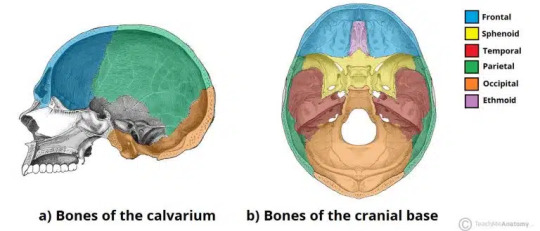
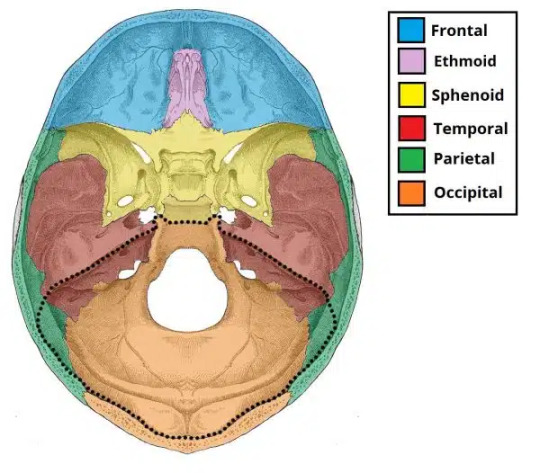
Vulnerability and the 'Off-Switch' Phenomenon
Encasement of the medulla in the foramen magnum of the occipital bone — an architecture formed for spinal cord continuity, rather than impact protection — subjects it to catastrophic damage in trauma. Clinical case series of occipital impact (e.g., falls, blunt trauma) exhibit the same: Forces transmied via the thin squamous occipital bone or condylar regions result in medullary compression or shear injury, and a sudden cessation of autonomic functions. This syndrome, colloquially known as the 'off-switch' effect, manifests in the guise of acute apnea, bradycardia progressing to asystole, and loss of consciousness — an incompatible triad with ongoing life.
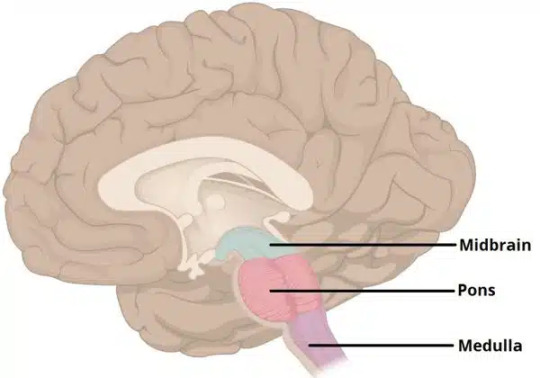
The biomechanics of such susceptibility are based upon fixed position of the medulla. Unlike the cerebral hemispheres, which are supported by cerebrospinal fluid buoyancy and septations of dura, the brainstem is supported by cranial nerve roots and denticulate ligaments that limit the brainstem's capacity to be displaced. Consequently, even minor osseous deformation — say, a basilar skull fracture extending into the clivus — may compress the ventral surface of the medulla, destroying the reticular activating system (RAS). The RAS, which controls wakefulness, is not functionally redundant; its permanent destruction results in coma or brainstem death, with the occipital region's fatal sensitivity.
This anatomical weakness has implications of great scope across specialities from trauma surgery to biomechanical engineering. In acute medicine, the 'occipital priority' guideline places prime importance on rapid stabilisation of neck and head to prevent secondary medullary damage — a practise validated by decreases in mortality in cases of atlanto-occipital dislocation. Neurosurgeons are confronted with moral complexities in managing irreversible brainstem damage, as medullary destruction always is subject to the determination of death under jurisdiction employing neurological criteria.
Furthermore, the vulnerability of the occipital bone has influenced protective technology. Modern helmet designs, for instance, prefer occipital reinforcement with multi-layered composites as a response to histological data that subjected the bone to comminuted fractures. Car headrests also aim to reduce hyperextension forces that can indirectly crush the foramen magnum.
Functional vs. Non-Functional Damage: Why Targeting Maers
The success of cranial interventions — clinical, tactical, or historical — depends on a fundamental anatomical fact: Neurological criticality is not uniformly distributed. The popular fallacy is that structural salience translates to functional necessity. The parietal and temporal bones, for instance, enclose the cerebrum, the locus of higher thought, sensory integration, and voluntary motor function. While injury to these regions may introduce dramatic clinical presentation — subdural haematomas, focal seizures, or aphasia — such injuries typically permit temporary survival due to bilateral organisation and functional redundancy of the cerebrum. A gunshot wound to the temporal lobe, even if potentially fatal secondary to secondary swelling or haemorrhage, may permit brainstem nuclei to be preserved, with intact autonomic function for a few minutes or hours. This creates a perilous scenario in tactical or defence contexts: an adversary with such injuries may still possess sufficient motor coordination to retaliate despite extensive cortical damage.
The target zone of the occipital bone, however, is a functional singularity. A projectile or impact force through this region risks direct injury to the medulla oblongata, which lacks the redundancy of the cerebrum. Neurophysiological shutdown in this location is not a gradual decline but an instantaneous failure of homeostatic control — an effect known as autonomic decoupling. Traditional histories of balefields, such as the correct coup de grâce techniques employed by medieval executioners targeting the occiput, or Roman gladius thrusts in the nape of the helmet, inherently accepted this dichotomy. Modern ballistic studies verify the same: kinetic energy transfer to the brainstem results in immediate loss of posture (through interference with vestibulospinal tracts) and quieting of the reticular activating system, rendering sensory-motor incapacitation absolute.
This dualism has both pragmatic and ethical dimensions. In police work, for example, reliance on parietal or temporal shots to neutralise threats offers non-lethal possibilities, leading to the potential escalation of interactions. Precise targeting of the occipital region — even though biomechanically perfect — is laden with humanitarian implications by virtue of being irreversible. Forensic pathology also makes this dichotomy more apparent: cerebral lacerations dominate homicide reports, whereas brainstem injuries are disproportionately linked to judicial or military interventions where instant lethality is maximised. The functional-non-functional distinction thus transcends anatomy, aligning with legal codes, combat ethics, and even the evolution of less-lethal technology.
Bone Structure and Ballistic Challenges: The Science of Penetration
The skull's heterogeneous structure — an admixture of dense cortical plates and spongy diploë — presents a dynamic challenge to penetrating energy. Terminal ballistics, projectile behaviour on impact, illustrates gross differences in cranial vulnerability. The 2–4 mm thick on average squamous portion of the occipital bone is very different from the 10–12 mm solid, labyrinthine petrous temporal bone. This difference is due to evolutionary demands: the petrous bone guards the cochlea and vestibular apparatus, which requires rock density, while the occipital region compromises between biped balance weight distribution and defence.
In ballistic situations, these fluctuations dictate outcomes. A 9mm parabellum bullet striking the petrous temporal bone at 90° can yaw or fragment due to the oblique slope and density gradient of the bone, truncating the depth of penetration. High-speed imaging studies demonstrate that rounds dissipate up to 60% kinetic energy on petrous fragmentation while preserving the middle cranial fossa integrity. Conversely, the occipital bone's relative thinness and perpendicular alignment to standard trajectories (e.g., rear-entry wounds) permit greater penetration. Military autopsy reports illustrate that 5.56×45mm NATO rounds impacting the occipital squama produce medulla oblongata penetration in 93% of cases versus 22% for temporal impacts — a disparity amplified by the occipital's proximity to the brainstem.
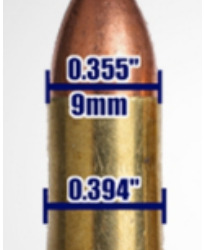
These principles hold outside the realm of ballistics. Occipital craniotomies in neurosurgery require precise burr hole placement to avoid dural sinuses, and temporal approaches require diamond-tipped drills to penetrate the petrous ridge. Even non-penetrating trauma follows this logic: occipital contrecoup injury from frontal impacts tends to crush the brainstem against the margin of the foramen magnum, whereas temporal impacts transfer energy through the zygomatic arch.
The implications for armour are profound. Modern combat helmets, such as the US Army's IHPS, employ occipital extension plates to counteract this deficiency. Vehicle ballistic glass, on the other hand, is angled to deflect rear-projectiles away from the Achilles' heel of the head. Nevertheless, material science is confronted with a paradox: More occipital armour risks compromising cervical mobility, reinforcing the age-old balancing act between protection and functionality.
Real-World Applications: Tactical, Historical, and Ethical Implications
The anatomical susceptibility of the occipital region and its shielding of the brainstem reverberate across fields, necessitating interdisciplinary analysis. In tactical environments, doctrinal overemphasis on the 'T-zone' (nasofrontal junction and orbits) or occipital targeting is commonly transmogrified into rote memorisation, divorcing technique from pathophysiological logic. Modern combat training manuals, such as the Close Quarter Combat Handbook of the British Army, encourage occipital shots in hostage rescue scenarios in order to minimise collateral risk — an approach grounded in the brainstem's 'neurological boleneck' status. Stress degradation of fine motor skills under most conditions makes operatives resort to less anatomically precise methods, such as centre-mass fire at high rate. Simulation work by Defence Science and Technology Laboratory (DSTL) discovers that only 34% of bullets that were shot in simulated states of stress actually struck targeted cranial targets, illustrating the disconnect between kinetic practise and theoretical training.
In the past, brainstem targeting fatality was exploited long before neuroanatomical maps existed. The misericorde, a medieval dagger that was employed to provide mercy strokes through the occiput, utilised the foramen magnum's exposure in combat with armour. Similarly, Edo-era Japanese kaishakunin (executioners) perfected seppuku techniques based on decapitation strikes aimed at severing the medulla, assuring instant death. These methods, though brutal, are an empirical understanding of functional neuroanatomy — a knowledge subsequently codified in 19th-century codes duello, where pistol shot to the back of the head was an honourable kill blow.
Forensically, cortical versus brainstem trauma is of enormous legal importance. A parietal gunshot wound may permit 30–90 seconds of agonal respiration, during which a victim could theoretically manipulate a crime scene or trigger defencive mechanisms. Occipital trauma leaves no such doubt: suppression of RAS activity excludes all volitional activity. This distinction has influenced criminal jurisprudence, specifically in R v. Dawes (2013), where the Court of Appeal overturned a murder conviction after forensic pathologists determined that the occipital wound to the victim could not immediately incapacitate, undermining the prosecution timeline.
Ethically, the brainstem's role as a biological kill-switch raises an accounting with the moral meaning of anatomical information. Bioethicists such as John Harris have equated medullary targeting with 'neurological euthanasia' — a mechanisation of death that bypasses higher consciousness, reducing human agency to a series of interruptible circuits. This model renders it hard to debate assisted dying, where medullary destruction could theoretically offer painless exits but could make anatomical precision normal as a tool of dehumanisation. The 2016 Lancet Commission report on Brain Death provocatively argued that irreversible brainstem damage would suffice for legal pronouncements of death, a stance opposed by disability groups who argue it undermines the sanctity of cortical personhood.
Conclusion
The Necessity of Knowing Where to Aim
To gamble on the weaknesses of the occipital bone without knowledge of its neuroanatomical stakes is to wield a blindfolded knife. The region's lethality is not merely a maer of bone density or ballistic convenience but of its evolutionary role as the final arbiter of autonomic survival. To this end, the injunction to 'know where to aim' functions outside tactical expedience — it is a metonym for the ethical burdens implicit within scientific mastery.
The vulnerability of the brainstem presents a double accounting: with the limits of human endurance and the hubris of those who would militarise its weaknesses. As the neurotechnologies spread — from directed-energy weapons systems capable of deploying non-penetrative disruption of the brainstem to AI-targeting systems — the boundary between precision and predation collapses. The 2021 UN Report on Lethal Autonomous Weapons Systems actively singled out medulla-targeting algorithms as morally troublesome, warning that 'automating the off-switch of consciousness risks divorcing lethality from accountability.'
However, this knowledge also carries redemptive possibilities. In neurosurgery, occipital craniectomies for the decompression of brainstem compression following trauma illustrate how anatomical accuracy can preserve life instead of ending it. Likewise, the development of non-invasive brainstem stimulation provides promise for conditions such as central sleep apnoea — a reflection of the double-edged nature of scientific advancement.
Lastly, the lesson of the occipital bone is a lesson of paradox: that the origin of life's most vital rhythms is both safeguarded and imperilled by a few millimetres of bone. To learn it is to balance on the razor's edge between biological imperative and existential danger — a borderland where knowledge does not merely empower but demands wisdom. As surgeon-philosopher Sherwin Nuland describes it, 'To master the body's machinery is to hold the threads of life and death; pull one, and the tapestry unravels.' Ignorance here is not merely dangerous — it is a failure of the duty to wield such power with reverence.
_
Verified Sources with Hyperlinks:
Occipital Bone Anatomy NCBI Bookshelf: [Anatomy, Head and Neck, Occipital Bone] (www.ncbi.nlm.nih.gov/books/NBK541093/)
Skull Base Biomechanics TeachMeAnatomy: [Bones of the Skull] (teachmeanatomy.info/head/osteology/skull/)
Forensic Neuroanatomy LHSC Trauma Centre: [Basal Skull Fractures] (www.lhsc.on.ca/critical-care-trauma-centre/basal-skull-fractures)
Surgical Anatomy ScienceDirect: [Occipital Bone Overview (www.sciencedirect.com/topics/neuroscience/occipital-bone)
#teeceecee#tccblr#true cringe community#tc community#tcc tumblr#true crume#adam tcc#smiggles#lanzaposting#Medicine
38 notes
·
View notes
Text
0 notes
Text
Constructing Confidently in a Complicated Environment With Structural Engineering Consultants in Melbourne
Melbourne is known for its architectural variety, which includes everything from sleek modern skyscrapers and creative mixed-use complexes to heritage-listed structures and Victorian terraces. The structural engineering consultants in Melbourne can help in this situation. It takes accuracy, skill, and an in-depth understanding of structural stability to traverse the intricacy of such a terrain. They form the basis of efficient, sustainable, and safe construction methods. Working with seasoned structural consultants ensures that every project is constructed on a solid, dependable basis in a city as vibrant and expanding as Melbourne.

Encouragement of Creative and Eco-Friendly Design
The structural forensic inspections responsibilities are growing beyond safety and compliance as Melbourne shifts to more ecologically responsible and sustainable development. To realise ambitious concepts without sacrificing structural performance, consultants collaborate closely with architects and designers.
They offer the technological know-how needed to enable creative ideas, from modern materials and modular construction techniques to green buildings and passive design concepts. Buildings created via this partnership are not only aesthetically pleasing but also effective, sustainable, and prepared for the future. They give a clear grasp of the structural ramifications of every design and construction decision by delivering comprehensive reports, models, and risk evaluations.
Improving Interaction Between Project Teams
A diverse range of stakeholders are involved in construction projects, such as architects, builders, surveyors, project managers, and clients. Technical coordination between these divisions is mostly handled by structural engineering consultants.
They aid in making sure that every component of the design and construction is structurally aligned and complies with the relevant requirements. They are useful to team members at every stage of the project because of their capacity to succinctly convey complex information and offer insights that can be put to use.
In the fast-paced, frequently high-stakes construction industry of Melbourne, this cooperative position facilitates efficient project execution. In the end, structural engineering consultants enable their customers to make knowledgeable choices through the building process.
Source: https://emsengineeringconsultancy.blogspot.com/2025/05/constructing-confidently-in-complicated.html
0 notes
Text
What Are the Key Benefits of Forensic Structural Engineering in Construction?
Forensic structural engineering plays a crucial role in identifying and analyzing the causes of structural failures. This specialized field helps engineers determine the root cause of building issues, ranging from design flaws to material defects. By applying investigative techniques, forensic engineers assess structural integrity, offering solutions to prevent future failures. Their work supports legal claims and insurance settlements, ensuring safety and compliance with standards.
The key benefits of forensic structural engineering lie in its ability to improve safety and prevent disasters. By conducting thorough investigations, it helps in diagnosing structural issues early, saving costs in the long run. Furthermore, forensic engineers contribute to designing better structures, enhancing overall building performance.
Check out our blog for more insights: https://appliedscienceint.blogspot.com/2025/04/what-are-key-benefits-of-forensic.html
0 notes
Text
I've been thinking about possible hankcon AUs I've never actually seen... Just imagine
Noir Detective AU
Connor as a young, brilliant but uptight federal agent. Hank as a grizzled, burned-out detective who doesn’t want a partner.
They’re forced to work together on a case neither of them wants. Their clashing worldviews make everything harder, until the case breaks open and so does their emotional distance. Classic “enemies to reluctant partners to… maybe something else.”
Fantasy AU
Connor as a scholar, mage apprentice, or monastery scribe with rigid discipline. Hank as a fallen knight, exiled warrior, or mercenary with a drinking problem.
They’re sent on a quest together, maybe to defeat an ancient curse, guard a village, or find a missing artifact. Connor wants structure. Hank wants everyone to leave him alone. Cue arguments, slow trust, and long nights by firelight.
Dark Medieval AU
Connor as a monster hunter, emotionally detached, trained for efficiency. Hank as an herbalist, woodsman, or ex-soldier who understands people, not magic.
They travel together to stop dark creatures, cults, and political rot. Connor is quiet. Hank is blunt. Their growing bond becomes a question of who protects whom, and what makes someone human.
(it could be vice versa as well. Hank as a monster hunter, Connor as a herbalist etc. which fits them even more)
Mafia/Narcotics AU
Connor as an undercover cop working inside a crime syndicate. Hank as a disgraced former detective who knows how the system really works.
Connor is told to find dirt on Hank. But the more they interact, the more he realizes Hank isn’t corrupt, just broken. Dangerous secrets, moral gray areas, and blurred lines follow.
Academic AU
Hank as a university professor (literature, philosophy, criminology etc.) Connor as a grad student or research assistant with a spotless academic record and zero social ease.
They work on a project together, forced into the same orbit. Their connection isn’t some cliché “hot for teacher” thing, it’s two people, both isolated in different ways, learning how to connect.
Corporate Thriller AU
Connor as a cybersecurity analyst or forensic accountant. Hank as an internal investigator or ex-hacker turned security consultant (or something that just fits him more).
Together, they uncover corporate espionage or AI-related corruption. Cold efficiency meets jaded intuition. Mutual frustration turns into mutual respect.
Post-Apocalyptic AU
Connor as a medic, mechanic, or survivalist — calm and precise. Hank as a former cop, now one of the few who can keep people together.
They survive together, in a train convoy, forest outpost, or walled city. It’s not about dramatic declarations. It’s about sharing food, fixing things, and staying human in a broken world.
Historical AU (1940s–1970s)
Hank as a hardboiled PI. Connor as a government lawyer, war veteran, or journalist.
They team up on a case that exposes systemic injustice and in the process, confront their own alienation. Queer-coded, quiet, full of unsaid things and cigarette smoke.
Sci-Fi AU (but no androids)
Connor as a genetically engineered human, not artificial, but grown for perfection. Hank as military or intelligence assigned to monitor him.
Connor struggles with identity, not programming. Hank sees a person when others see an asset. Their bond builds not on rebellion, but choice and learning what “being human” really means.
And of course, they fall in love with each other in each of these AUs and live happily ever after! Or... at leas quite happily.
#hank anderson#dbh hank#dbh#dbh rk800#dbh connor#connor x hank#detroit: become human#detroitbecomehuman#detroit become human#hankcon#rk800#connor rk800#detroit rk800#fandom#ship dynamics#gay ships#any au
17 notes
·
View notes
Text
hey, what's your major again?
summary: my credible expert opinion on what the aot characters would study in university. what are my qualifications? the dozens of hours i’ve spent staring at my school’s program bulletin trying to figure out what i’m majoring in
genre | includes: headcanons, sfw, minor language, uninformed percy jackson reference (pls don't hate me if im wrong)
characters: eren jaeger, mikasa ackerman, armin arlert, sasha braus, jean kirschtein, connie springer, historia reiss, ymir, reiner braun, annie leonhardt
author’s note: had this in my drafts for months now. i just need to post it so it stops haunting me. might do the rest of the marleyans and vets in the future! lmk your thoughts, my only tumblr notifications are from p*rn bots, so i'd love to hear from real people lol. enjoy <3

eren: sociology and public policy, 4+1 program for a social work masters
there’s only so many times you can hear “you’re gonna be a doctor just like your dad” before you start to believe it. that’s why eren started out with biology on the premed track. the thing is, he really didn’t care for it. eren is really passionate about lessening equity gaps and is a firm believer in “if you want something done right, do it yourself”. this is why i see him making the switch to a double major in public policy and sociology. he wants to know about how society got to the point of perpetuating disparities so that he can fix them. but he also knows that the government fucking sucks and thinks its naive to expect policy change to be the only method of change. and like the maniac he is, eren is enrolled in a 4+1 program so he can get his master’s in social work when he’s done with his undergrad. he’s determined to graduate with both degrees in just 4 years though. rip his summers.
armin: international relations and military ethics, minor in communications or smth
everyone always says armin would study marine biology or oceanographic studies, but i honestly think that it’s a passion that he pursues on the side. he takes marine bio courses for his breadth requirements, but knows he’d end up hating the ocean if he spent the rest of his life studying it. he also strikes me as someone who would rather run buck naked into traffic than sit through multiple semesters of organic chemistry. armin was always a good public speaker, though, despite being a bit insecure. that’s why his speech and debate teacher during sophomore year of high school recommended model united nations to him. he was hooked after his first conference and now genuinely sees the path of international diplomacy as his calling. that’s why he’s majoring in international relations. his concentration in military ethics is something he tacks on in his junior year after taking some courses and publishing research with dr. erwin smith. he probably minors in communications because he can.
mikasa: forensic science
mikasa had no idea what she wanted to do when she started uni. she’s good at nearly everything. like never gotten a B in her life and is the student who the curve is based off of. but excelling in every environment you’re put in often means you don’t know what you’re best at. she knew deep down that she wanted to do something justice related like her childhood best friends did, but she’s no public speaker and has no interest in political reform. she was, however, emo in high school and heard a fair share of undertaker jokes at her expense. it wouldn’t hurt to look into right? as cool as the title sounds, morticians don’t make enough money for the job they have. fortunately enough, forensic pathologists do and mikasa looks good in a lab coat. she would never admit it to spare armin and eren’s feelings, but when they, as children, recreated the crime-solving shows mrs. jaeger always had on, mikasa always wanted to be the brains. so criminology and forensic science it is. (side note: she definitely joins the military and they pay for her education)
jean: structural engineering and industrial design with a minor in studio art
more than anything, jean wants to provide for his mom and knows he can’t guarantee a retirement of luxury for her as the freelance artist he wishes he could be. he’s decent at math when he tries and doesn’t hate physics, so he decided he’d give structural engineering a try for at least a semester or two. he wasn’t expecting to get much from it, to be honest. he had a plethora of backup plans waiting for his supposedly inevitable distaste for engineering, but he found that he didn’t hate it at all. someone once told jean that he had the makings of a great leader and he didn’t believe them until he started taking the lead on design projects and producing incredible results. his only qualm is that he just doesn’t get to be as creative as he wanted to be. that was easily rectified by an additional major in industrial design and a minor in studio art. he’s unbelievably busy, busier than he anticipated when he started his post-secondary journey, but he’s content and there’s nothing some extra coffee can’t solve.
sasha: environmental science and sustainability
sasha spent her childhood ankle-deep in mud and fighting her way through forest thickets without a compass. an upbringing like that doesn’t leave your spirit, no matter how far into the city you go for school. so sasha’s always been passively passionate about the environment. that passiveness became significantly more prominent when part of the woods she grew up in was cleared out to build an industrial complex. it was then that she started researching and writing petitions about preserving wildlife and making environmentally conscious decisions. her work actually got her the scholarship she’s on (because god knows it wasn’t her grades). and she genuinely loves what she does, so why wouldn’t she keep learning about it? the environmental science and sustainability program at the school is small, but tight-knit and known for churning out changemakers. sasha knows she’ll be one of them one day. just hide your plastic straws from her, okay?
connie: computer science and chinese
stick with me here okay? everyone expects connie to be a douchebag marketing major whose hardest assignments are graphing functions and making posters on photoshop, but he’s a lot more invested in his education than he looks. don’t get me wrong, connie has always struggled academically, but that’s because so much of early education is pre-determined. he performed way better when he could choose what courses he took. it’s kind of like percy jackson being dyslexic in english because he was wired to read in greek. connie can’t keep his eyes on a history textbook for shit, but will gladly sit in front of the c++ code on his pc for hours. he doesn’t even get mad when he realizes that he was missing a semicolon. connie loves how versatile of a future he could have with a compsci degree, because, let’s be real, he could never survive in a typical office environment. definitely takes a bunch of chinese classes and doesn’t realize that he has enough credits for it to be a minor until his second to last semester.
historia: political science with a minor in international relations and child development
historia is a lot like eren in the sense that she knows her time is best spent doing hands-on work in the fields she cares about. she realizes this sometime after reconnecting with her estranged father and volunteering at the orphanage she grew up in. but now that she’s publicly associated with a powerful political figure, historia doesn’t get to do what she wants, only what is expected of her. that’s how she ends up on the pre-law political science and public policy route. the nickname “ms. president” that connie and sasha give her only further reminds her that she’s heading down a path she never wanted for herself. after lots of encouragement from ymir, historia decided to take child development courses on the side. even if she doesn’t take on the full minor, she’s taking some classes she cares about. maybe she’ll find use for it someday. at the very least, it’s her first step in becoming the most selfish girl in the world.
ymir: data science and business management
ymir is smart. much smarter than she presents herself to be, almost as a form of protection. nobody expects much of someone who is aloof, so it makes it easy to slip through the cracks to remain safe and comfortable in the shadows. business management is notoriously low commitment and easy to skate by with. guaranteed internships, post-graduate employment, and so on. To anyone who doesn’t know ymir well, it’s perfect. but they have her mistaken, ymir will do as little as possible to go as far as possible. sure, she can live comfortably with a business degree, but it could be better with a little bit of data science in her arsenal. she’s intelligent enough to pick up on it, and determined enough to make it her bitch. yeah, academia is a money-sucking pipeline into the capitalist hellscape, she doesn’t believe in it yada yada, but at the end of the day, ymir’s gonna get the bag. so what if she’s gotta sleep through some stats classes to get it?
reiner: behavioral economics
reiner’s mother had convinced him his whole life that getting a high paying job would fix their lives and bring his father back. believing “perfect grades lead to a perfect life” made high school tough for reiner; gifted kid burnout is no joke. it really messed him up. he wasn’t sure if he could withstand the pressures of university, but here he is. reiner was never allowed a therapist, so he figured pursuing psychology would, at the very least, give him some answers and be a good pathway to a medical degree. he loved getting to understand how people work and why they act the way they do, but something was missing. he found out what it was when a guest lecturer spoke in his economics class. he knew making the switch would be risky, it’s a new field and his current career options are really only research, academia, or government, but the interdisciplinary study of behavioral economics is calling reiner’s name.
annie: biomedical engineering and kinesiology
annie’s entire life revolved around her father, including the injury he was never able to heal from. the one she gave him. he’s claimed to be over it, she’s forgiven, but annie will never feel like she’s earned that forgiveness until she gets rid of the problem entirely. how is she going to do that exactly? with biomedical engineering. she has years of hell in front of her, especially with her concentration on biomechanics, but she doesn’t care. annie will throw herself into her work to get the results she wants. she takes the highest amount of credits possible every semester so she can graduate early. you’ll most likely find her chained to a study cubicle at the library at all hours of the day and running on 2 hours of sleep, but it doesn’t faze her. she tacks on a minor in kinesiology because it makes sense and she had most of the credits for it anyway. and as if it couldn’t get worse, she probably TAs for a thermodynamics course or something crazy like that.

© mamasbakeria 2023. do not repost, translate (without permission), or modify
#gbemi.writes#aot#attack on titan#snk#shingeki no kyojin#aot headcanons#snk headcanons#college au#eren jaeger x reader#eren x reader#mikasa ackerman x reader#mikasa x reader#armin arlert x reader#armin x reader#jean kirschtein x reader#sasha braus x reader#connie springer x reader#historia reiss x reader#ymir x reader#reiner x reader#reiner braun x reader#annie leonhardt x reader#eren headcanons#armin headcanons#reiner headcanons
271 notes
·
View notes